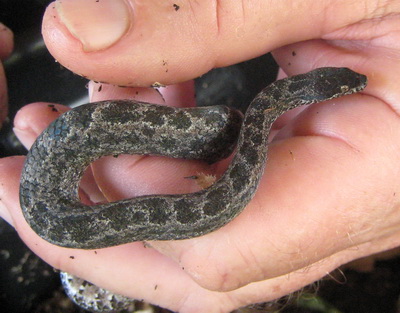Protect our wild life and I hope everyone enjoys these photos.
Marta

Protect our wild life and I hope everyone enjoys these photos.
Marta

Barry is always into new and different things and here he is rooting around trying to find a Pygmy Boa.
We now have a bin that we created for our compost worms filled with moistened shredded paper which we feed every three days or so with scraps of fruit, vegetables, egg shells and coffee grounds. So when Barry found a Pygmy Boa in our wash house at Harbour Club Villas last night, he popped it in with the worms. I wanted to take photos in the day light so we had to find a temporary home for it.

Here's some of the worms and in about another four months, we should be able to harvest the finished compost.

This Pygmy or Dwarf Boa is about 12 inches long which is about the size that they grow to here in the islands.
These snakes are non poisonous and harmless. They have a yellow or orange tailtip which serves as a lure to their prey and also apparently the colour may discourage predators.
The Turks and Caicos Dwarf or Pygmy boa is endemic to these islands meaning that this snake is only found in the Turks and Caicos Islands.
Our island snakes are at risk and are preyed upon by cats, dogs and rats. In the past, Barry has shown boas we’ve found to several of our local friends and visitors to Harbour Club so that they can see how harmless these snakes really are. Next time you are fortunate enough to see one, remember that they need our protection in order to survive here in the Turks and Caicos.
Marta
The Turks and Caicos Islands have no venomous snakes……..thank goodness!! What we do have so far is three species of snakes, the largest is the Bahama Rainbow Boa or Bahama Cat Boa, the Caicos Islands Pygmy Boa known locally as the Chicken Snake and the rarely seen Richard’s Worm Snake that burrows in the earth and looks very much like a pink earthworm.
The Caicos Islands Pygmy Boa is endemic to the Turks and Caicos Islands. In other words, it’s not found any where else in the world. This snake has a range of colourations from gray and black speckled to a deeper reddish brown. The tip of the tail is a bright orange which they use as a form of defense. The boa will curl up in a ball when threatened and wave the orange tipped tail to protect their heads which are quite vulnerable.
I found this little Boa curled up under a bunch of dead leaves in one of our planters and since Barry loves snakes, he kept it to show Olique. We’ve had several Pygmy Boas here at Harbour Club Villas and one time years ago when we were building, Barry rescued one that was about to be killed by the workers. He patiently showed the workmen that it was harmless and actually got them to handle and hold this unique little creature. All our snakes were released and we would hope are around here somewhere.
Check out the orange tail tip in the above photo. This Pygmy Boa will eat ants, termites, mice, rats and small lizards and geckos so they are great to have around. They grow to less than a foot long and are the smallest Boa Constrictor in the world and as such, this fact has made them famous. Make sure you don’t harm these beautiful and rare snakes should you happen to find one.
Marta